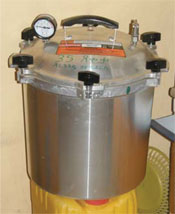6.2.1 The importance of good maintenance

All equipment must be cleaned, inspected and kept in good order. Defects must be identified and reported to the woreda Health Office immediately. Equipment must always be returned to its correct place after use.
Can you suggest any reasons for maintaining equipment efficiently? Look again at the list in Table 6.1 to help you think about what could go wrong if the items of Health Post equipment are not in good working order when needed?
You may have thought of:
- Drugs, vaccines and other consumables that need to be kept cold will be unusable if the refrigerator breaks down or the cold box is damaged.
- If the steam steriliser (Figure 6.3) is not working properly, infection could result from the use of dirty instruments from the midwifery kit.
- If the torch and battery are not properly maintained, you may not be able to see the client adequately if you are called to a house that has no electricity or kerosene lamps.
- Dirty or damp equipment deteriorates more rapidly than equipment that is kept clean and dry – poor maintenance leads to more breakdowns; equipment that is well cared for and returned clean and in good order to its correct place after use will last longer and has to be replaced less often.
The maintenance of all equipment is essential to ensure that it functions correctly and efficiently. Simple maintenance of equipment may be carried out by you at Health Post level, but in most cases trained or assigned technicians or engineers will be sent to the Health Post by the woreda Health Office, to maintain equipment such as the refrigerator or steriliser if they break down.
6.2 Management of equipment
